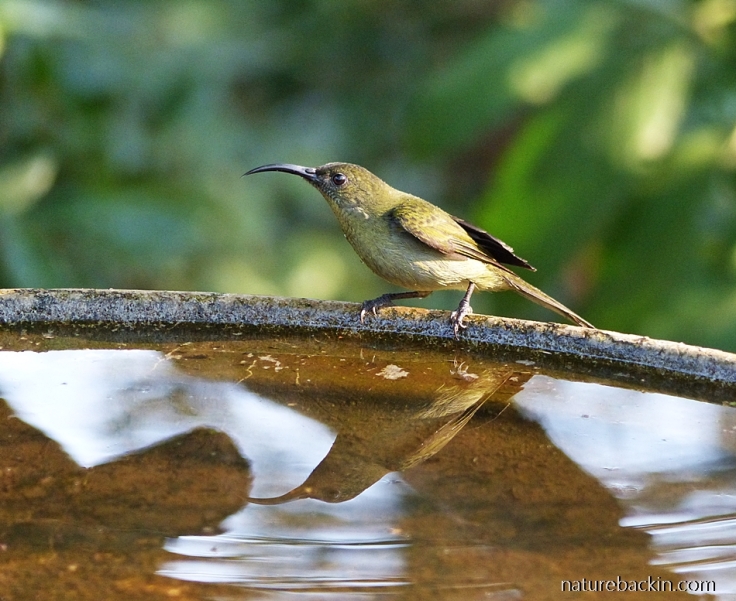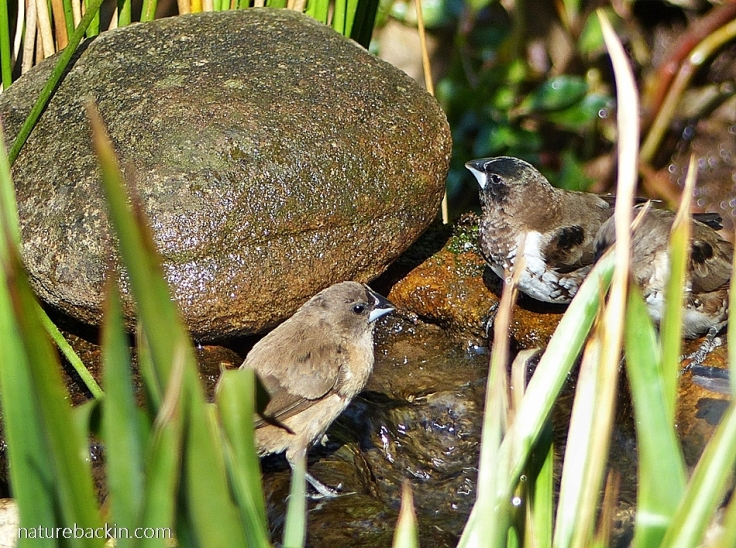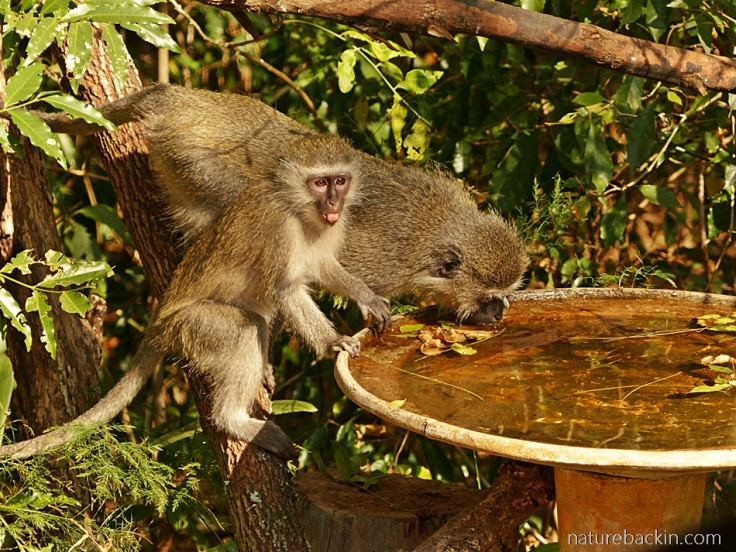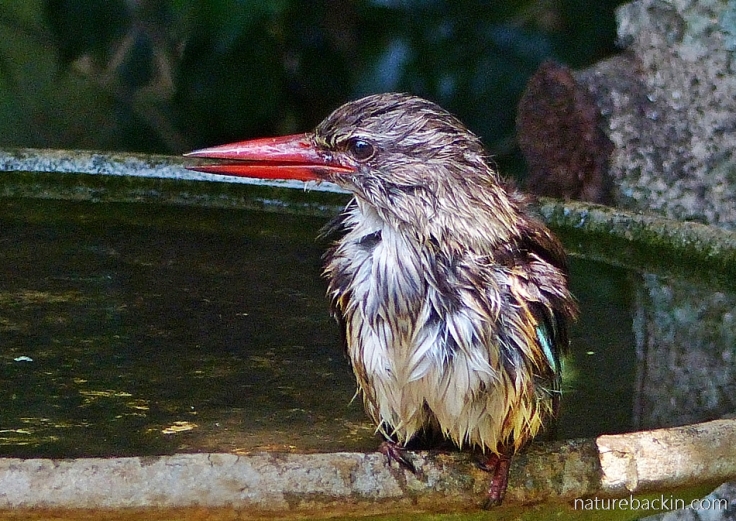The main seasons in our part of the world are only two: wet season and dry season. But prolonged drought over much of the country has erased that distinction into one long dry bleakness where rain of any significance is a memory or a hope.
There is nothing like a dry and unusually hot winter and the fear that spring will not bring needed rain to make me more mindful of water than would be the case in kinder circumstances. This post features photographs taken over several years in our garden where water is the sustaining theme. In the top photo above, Vervet Monkeys queue up to drink at a bird bath in a very hot dry spring season back in 2015.

A female Greater Double-collared Sunbird (above) is about to enjoy a drink at one of our garden birdbaths
The birdbaths are in great demand throughout the year. In urban and suburban areas it can be hard for birds and other creatures, including insects, to find water, especially in the dry season. In our area on the edge of town, thirsty timber plantations have dried up many of the water courses adding to the hardships faced by wildlife that still manages to exist in the suburbs and on the fringes of the urban areas.

When starting this blog, I wanted to celebrate the ordinary. What could be more ordinary or more basic than water? And what is more precious? In the current context even a small garden pond such as ours (above) is a luxury. We have rainwater tanks that store water for us to use during water outages (when our supply is interrupted), and we also use this stored rainwater to water the odd plant or two and to top up the pond and the birdbaths in the dry season. We have been fortunate so far that these tanks retain enough water to see us through the dry months of winter.

Guttural Toads spawning during spring in our garden pond. The strands of spawn can be seen
A recent report (released 6 August 2019, see here) by the World Resources Institute (WRI) notes that since the 1960s, water withdrawals globally have more than doubled and the demand continues to grow. The WRI reports that across 17 countries one-quarter of the world’s population faces ‘extremely high’ levels of baseline water stress, where on average each year irrigated agriculture, industries and municipalities draw off more than 80% of the available supply.
A further 44 countries face ‘high’ levels of water stress. It is noted that even in countries where overall the water stress level may be lower, some regions within some of these countries face high levels of water stress. In countries and regions with high levels of water stress where there is a narrow gap between water supply and demand, changes in supply, due to drought for example, or increases in demand/usage can quickly escalate into a crisis. Not only are rural and farming communities at risk, but even large cities are vulnerable. Recent examples of cities running close to “day zero” when the water supply is shut off include Chennai (India) and Cape Town (South Africa). Many other cities are subjected to ongoing water rationing and in many cities many residents do not have reliable (or any) access to a supply of piped water.

A Kurrichane Thrush and Cape White-eyes enjoying the water in the birdbath. Access to clean water is not something that can be taken for granted
The WRI notes that contributing to water stress is the increasing demand for water related to population growth, socioeconomic development and urbanisation. Climate change “can make precipitation and demand more variable” (for more information see https://www.wri.org/blog/2019/08/17-countries-home-one-quarter-world-population-face-extremely-high-water-stress).

Bronze Mannikins drinking at the garden pond
The WRI report stresses that improved water management can help secure our water supplies. There are many steps that can be taken to improve water security and the report highlights three areas where water stress can be reduced by better water management: increasing agricultural efficiency; investing in built infrastructure (such as pipes and treatment plants) and investing in “green infrastructure” or natural water harnessing systems (such as wetlands and healthy watersheds); and treating and reusing water. Of course using water more wisely and sparingly wherever possible is also an important dimension to water conservation, as is not polluting our water systems.

It is not only birds that utilise our birdbaths and pond. In the past few weeks of high temperatures and no rain or dew, high numbers of honeybees have been using the pond and birdbaths

A hoverfly drinking at the garden pond. Pollinators such as honeybees and hoverflies (important for our food security) may also be subject to water stress as much as larger species of animals
In addition to the high winter temperatures and prolonged drought in many parts of South Africa, other recent stories related to the global water situation and climate change have also caught my attention. The widely reported Arctic fires in July (see for example here) and the record melting of the Greenland Ice Sheet (see here) have made me fearful. It has not been a good month.

Meanwhile back home in our hot winter garden the Vervet Monkeys are making regular use of the birdbaths. This picture was taken too early in the day for the arrival of the honeybees, but later in the morning the monkeys have to brave the numerous bees when they try to share the birdbaths

An adult and a juvenile Vervet Monkey share a drink from a birdbath
So, I am trying to work out if it is possible to find a sense of equilibrium in these uncertain times when even counting ones blessings can seem like the height of insensitivity. To get some insight into the day-to-day plight of a someone living in a village (in the Eastern Cape, South Africa) where “the taps had been dry for more than a year, the local dam was down to 10% capacity and the heat and the wind were blowing through her village with the promise of suffering to come”, see this article by Kevin Bloom published by the Daily Maverick.

Having potable water coming out of the taps, enough rain to store in the rainwater tanks and enough water to share with the local birdlife, such as this kingfisher, is not an ordinary thing
In the face of the bigger picture and the bigger challenges it is not irrational to feel overwhelmed. But trying to do small things to make a difference to the lives of individuals and to local biodiversity and to conserve our resources is something to hang on to.
I end by providing a link to a post at The Little Silver Hedgehog on providing water for wildlife, especially hedgehogs https://littlesilverhedgehog.com/2019/07/24/water-for-wildlife/. The Little Silver Hedgehog is the blog of Emma Farley who runs a hedgehog rehabilitation facility at her home in Yorkshire, UK. She funds her work in part through the silver jewellery that she designs and makes herself, so do check out her blog to see both the jewellery that can be ordered online and to read about her wonderful wildlife garden and the great work she does helping hedgehogs that have been injured or are in need of assistance.
And if you need something to cheer you up do look at another Silver Hedgehog post featuring a video of an excited baby hedgehog indulging in behaviour known as “self anointing” when eating some especially delicious food! https://littlesilverhedgehog.com/2019/06/24/baby-hedgehog-hoglet-self-annointing-warning-super-cute-video/

Sources:
Bloom, Kevin. 2019. Food, drought and fury: UN land report brings the truth to SA’s corrupt. August 12. Our Burning Planet Analysis. Daily Maverick. https://www.dailymaverick.co.za/article/2019-08-12-food-drought-and-fury-un-land-report-brings-the-truth-to-sas-climate-corrupt/; Cassella, Carly. 2019. Wildfires Ravaging the Arctic Right Now are so Intense, You Can See Them from Space. July 26. Science Alert. https://www.sciencealert.com/unprecedented-wildfires-are-ravaging-the-arctic-and-the-images-from-space-are-astonishing; Hofste, Rutger Willem, Reig, Paul & Schleifer, Leah. 2019. 17 Countries, Home to One-Quarter of the World’s Population, Face Extremely High Water Stress. August 6. World Resources Institute (WRI). https://www.wri.org/blog/2019/08/17-countries-home-one-quarter-world-population-face-extremely-high-water-stress; NSIDC. 2019. Greenland Ice Sheet Today. Europe’s warm air spikes Greenland melting to record levels. August 6. National Snow and Ice Data Center (NSIDC). http://nsidc.org/greenland-today/2019/08/europes-warm-air-spikes-greenland-melting-to-record-levels/; World Resources Institute (WRI). 2019. Release: Updated Global Water Risk Atlas Reveals Top Water-Stressed Countries and States. Press Release – August 6. https://www.wri.org/news/2019/08/release-updated-global-water-risk-atlas-reveals-top-water-stressed-countries-and-states
Posted by Carol









August 29, 2019 at 10:50 am
A frightening article on water stress. Thank you for writing so clearly about the crisis, and offsetting the bleakness with your beautiful photographs
LikeLiked by 1 person
August 29, 2019 at 3:02 pm
Thanks Mariss. I decided to share information about the recent report on water stress, especially as it does include constructive recommendations, even though I know there is so much we already feel so bleak about …
LikeLiked by 1 person
August 20, 2019 at 1:33 am
I have yet to go to the hedgehog for some cheering up (but I intend to do so). Just the word ‘hedgehog’ alone reminds me of the wonderful feel of holding one of those delightful little critters in my hands. They are beyond sweet.
We live in “interesting times” and it can get downright depressing thinking about it. We’re anxiously looking forward to some winter storms. The summer has been extremely hot and dry. The trees seem to be expressing their stress by dropping their leaves early. We have a government which is doing everything it possibly can to exacerbate the decline. There are times when we probably need to stick our head in the sand to preserve our sanity, but then all that’s left to do is to cling to some sense of hope and do what we can locally.
A lovely and thought provoking post (though, I’ll admit a touch depressing). ❤
LikeLiked by 1 person
August 22, 2019 at 6:13 pm
I hope in due course the delightful hedgehog provides some cheering up.
Sorry about the depressing post, but sometimes reality really does bite. I hope that you do get rain soon as the summer sounds to have been stressful not only for the trees. And as for the assault on environmental protection by your current government (and many others too) it can be hard to know what it means to “keep a sense of perspective”. But we have to keep on trying one way or the other … Thanks Gunta.
LikeLike
August 18, 2019 at 6:44 am
A very thoughtful post and terrific photos, as always. It sounds like your situation in South Africa is particularly tenuous. There are so many places in the world where the weather is changing, but people’s water usage has not yet adjusted to this change. Here in Hawaii, we’re still getting a lot of rain on the wet sides of the islands, but here have also been long droughts in other areas. I do think rainwater collection is a good thing, regardless of how much rain falls where you are, and providing water sources for wildlife is a very noble endeavor.
LikeLiked by 2 people
August 19, 2019 at 5:52 am
Thanks Graham. The demand for water needs solutions at policy levels but at the same time using water carefully at the household and workplace level also contributes to conserving our supplies. I agree that collecting rainwater for house and garden use seems sensible, and in some places it can be really necessary through the dry times. We also release our ‘grey’ bathroom water into our garden, though the siting of the house limits where we can easily release the water to (using only gravity for the water flow).
LikeLiked by 1 person
August 19, 2019 at 7:05 am
At my former house I put in a system where rainwater was collected in an underground tank and then a solar powered pump transferred it to a higher tank for use by gravity feed. It worked pretty well. Of course you’ve still got to have that wet season to collect the rainwater!
LikeLiked by 1 person
August 22, 2019 at 6:06 pm
It sounds like a great system to have – assuming of course that the rain does indeed fall!
LikeLiked by 1 person
August 17, 2019 at 3:26 pm
After reading your post I really needed the link to the blog about the hedgehogs! Of course not due to your lovely pictures, but the facts about the climate disaster are depressive.
LikeLiked by 1 person
August 19, 2019 at 5:42 am
It is hard not to be despondent and important to figure out how to try to be constructive, which is perhaps easier when feeling cheered up by hedgehogs and such like ☺
LikeLike
August 17, 2019 at 12:42 pm
These beautiful shots of creatures drinking and splashing belie the realities of the situation. Reading your thoughts and some of the comments which follow reinforces how serious things are. Worrying times indeed.
LikeLiked by 2 people
August 19, 2019 at 5:38 am
Thanks Sandra. Hopefully policies will change to catch up with what is happening …
LikeLiked by 1 person
August 17, 2019 at 11:48 am
Excellent thoughts and observations, plus a great deal of research and excellent photos. Your blog is exactly how I feel. We can all do our small bit in a water scarce country. xxxx
LikeLiked by 1 person
August 19, 2019 at 5:36 am
Thank you Christeen. It is nice to have had a second sprinkle of rain – at least it made a few frogs chorus for a few nights 😊
LikeLiked by 1 person
August 17, 2019 at 8:24 am
Excellent and sobering post, thank you Carol. Real food for thought.. lovely photographs too.
LikeLiked by 1 person
August 19, 2019 at 5:34 am
Thanks very much Carol.
LikeLike
August 16, 2019 at 9:28 am
Thoughtful post.
I don’t have a bird bath – well I did, but one of the dogs accidentally knocked it over and it broke, so these days I put small basins around the garden, and we also have a pond.
When I water, I ensure to water the citrus trees as the sunbirds love to flit between the branches, cool off and bathe.
LikeLiked by 1 person
August 16, 2019 at 12:34 pm
Thanks Ark. I suppose birdbaths being elevated give birds a margin of relative safety from cats and other predators, but shallow bowls and ponds with shallow ends also do the trick. I have also seen sunbirds enjoying spray from a hose and droplets on the leaves. Very cute to see them get so excited 🙂
LikeLiked by 1 person
August 16, 2019 at 5:58 am
The work of the Little Silver Hedgehog and others is well known round here of course. If only we saw hedgehogs. It must be a year at least. And ensuring animals have water continues to be important here. Hard to imagine in a thoroughly water-logged year with floods in recent weeks. Worrying times, when individual behaviours seem to mean so little.
LikeLiked by 1 person
August 16, 2019 at 6:19 am
Sad that hedgehogs appear to be on the decline. Water extremes one way or the other is becoming disturbingly normal. I agree that individual behaviour can seem irrelevant, but there are instances were ground swells of ‘public opinion’ can influence environmental policy for the better. I was going to say perhaps I am clutching at straws but then remember that the plastic straws issue is a case in point …
LikeLiked by 1 person
August 16, 2019 at 7:50 am
Well, Greta Thunberg seems to have rattled a lot of cages. Individuals can make a difference.
LikeLiked by 1 person
August 16, 2019 at 9:00 am
Sounds like a call to action: Keep on rattling!
LikeLiked by 1 person
August 16, 2019 at 5:12 am
We are in a dire situation here too, and have just had water restrictions imposed. There has been very little rain over the winter and I worry that I won’t be able to keep my garden alive when the hot weather comes. I have noticed far fewer insects in the past year or so, and I guess it would be about three years since we saw the creeks running. It’s a very serious situation.
LikeLiked by 1 person
August 16, 2019 at 5:37 am
I am sorry that your region is in such a serious water-scarce situation. Water is our most basic and essential requirement and it requires more care and respect even when there is not obvious scarcity. I hope the water restrictions in your area are respected and that rain is forthcoming. I imagine that you are dreaming of the creeks running again.
LikeLike
August 16, 2019 at 4:38 am
A timely post. Our water supply is switched off from 8p.m. until 5 a.m. and we are now rationed to 25 litres per person per day – not an easy situation. Yet, in the light of what you have written, people have been prepared to spend money sinking boreholes and happily put up ‘borehole water’ signs on their garden perimeters to explain their lush lawns and use of sprinkler systems. Whose water is it anyway!
LikeLiked by 1 person
August 16, 2019 at 5:27 am
Thank you Anne. To say that your water situation is not easy is an understatement. What will happen if there is not enough rain this coming season is a haunting spectre. I agree that using borehole water so frivolously as if it is an unlimited resource is beyond selfish. Our communities are so splintered.
Thinking of you and all communities with water shortages and empty dams in the Eastern Cape and elsewhere.
LikeLike
August 16, 2019 at 2:56 am
Our country is obsessed with Eskom’s woes, and rightly so, but I fear we are not paying anywhere near as much attention to what is happening at the various water boards and the country’s water supply in general. I would much rather try to get along with electricity than try to get along without water.
Your fantastic images of beautiful creatures relishing the ready supply of water in your garden is in sharp contrast to the horrors described and predicted in your wise words today, Carol. I hope people sit up and listen.
LikeLiked by 1 person
August 16, 2019 at 5:16 am
I agree that not enough attention is paid to the dire deficiencies in our water management, where avoidable pollution is contaminating our already scarce available water. Many areas are already in a state of crisis with no water in the taps or nearly empty dams so what does it take to make water management a priority also at municipality level?
Thank you for your supportive comment. I hesitated to publish this post as we are faced with so much that is worrying and that can sometimes feel paralysing, but in the end I decided to share such unavoidable concerns.
LikeLiked by 1 person
August 16, 2019 at 12:31 am
Scary indeed. We’re already beginning to see ‘resource wars’ and refugee migrations due to climate change. Hold on, we may have a bumpy ride ahead. 😦
LikeLiked by 1 person
August 16, 2019 at 5:00 am
Indeed. Climate change is so obviously not a prediction for a postpone-able future. It is horribly now.
LikeLike
August 15, 2019 at 9:51 pm
Great post with lovely photos. 😊
LikeLiked by 1 person
August 16, 2019 at 4:57 am
Thank you Irene. It is beyond sobering when absorbing that so much that we celebrate is under profound threat.
LikeLiked by 1 person
August 16, 2019 at 1:32 pm
Hope you get relief from the dryness very soon.
LikeLiked by 1 person
August 19, 2019 at 5:33 am
Thank you Irene.
LikeLiked by 1 person